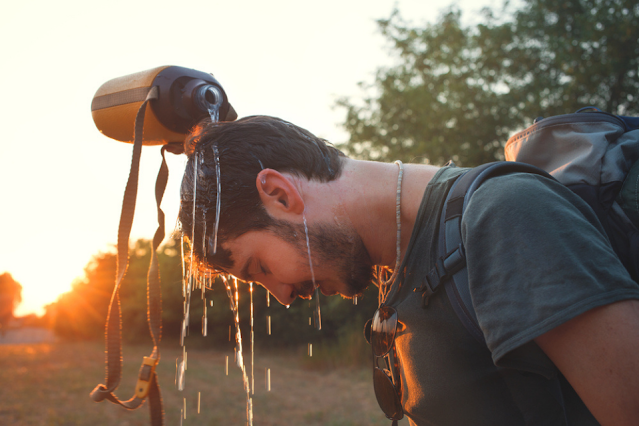As a Service Member, you’ve probably heard of heat illness, heat injury, heat exhaustion, heat stroke, or other heat-related complications. Since they’re not all the same, it’s important to know the signs, symptoms, and available treatments, so you can perform well in the heat and humidity.
Heat illness vs. heat injury
Heat illness and heat injury aren’t the same thing. A heat injury is part of a range of heat illnesses, but not all heat illnesses are heat injuries. The U.S. Army defines heat illness as a spectrum of disorders from work and heat stress that includes heat cramps, heat exhaustion, heat injury, and heat stroke. You experience heat injury when your body core temperature is over 40–40.5°C (104–105°F) and your internal organs are either damaged or don’t function normally.
 Be prepared to beat the heat Find Out More
Be prepared to beat the heat Find Out More
Heat-illness spectrum
Heat cramps are painful muscle cramps that happen when you’re exercising or working in the heat. While they’re not life-threatening, heat cramps still can be confused for other harmful conditions such as exertional rhabdomyolysis (breakdown of muscle tissue that can cause severe muscle pain, weakness, swelling, and kidney damage), which can be deadly. Treatment for heat cramps is to stop activity, rehydrate, and stretch the cramping muscle.
Heat syncope is when you faint due to the heat. Fainting happens when blood pools in your legs, causing your brain to say, “Turn the body off, then on again,” so it can get oxygen to itself. Keep in mind that as long as a heat-syncope casualty doesn’t hit something on his or her way down, it’s not life-threatening. In addition, the Service Member will be fine as long as she or he is removed from the heat. However, the only way to distinguish heat syncope from heat stroke is by measuring core temperature: a heat-syncope casualty’s core temperature is less than 40.5°C (105°F). Treat heat syncope by moving the casualty out of the heat and raising his or her legs above the heart. Blood flows faster to your brain when you lie flat on your back and everything is level.
All heat illnesses aren’t the same, so it’s important to know the signs, symptoms, and available treatments, so you can perform well in the heat and humidity.
Heat exhaustion is an inability to continue exercising or working. A heat-exhaustion casualty might or might not collapse, but—either way—she or he can’t keep working. Heat exhaustion is most common in those who are overweight (with a BMI of 27 or higher) and dehydrated, though it can happen to anybody. Like heat cramps and heat syncope, heat exhaustion isn’t life-threatening. In fact, a heat-exhaustion casualty’s core temperature is less than 40.5°C (105°F), which is what separates it from heat stroke. Like heat cramps and heat syncope, the treatment for heat exhaustion is to stop activity, get out of the heat, rehydrate, and elevate your legs.
Heat stroke, also known as an exertional heat stroke, is a severe heat illness defined by a casualty’s core temperature of 40.5°C (105°F) or higher. Heat stroke is life-threatening and can lead to heat injury (internal organ damage) or death if not properly treated. In addition to high core temperature, a common symptom of heat stroke is central nervous system dysfunction such as loss of consciousness, confusion, disorientation, agitation, and coma. Some of these symptoms also can occur in heat exhaustion and heat syncope though, so an accurate core temperature is required. It’s a common misconception that a heat-stroke casualty will have stopped sweating. If a heat casualty is displaying other signs of heat illness but is still sweating, DO NOT rule out heat stroke.
Since core temperature is often the only distinguishing symptom of heat stroke, an exact measurement is needed. The ONLY way to accurately measure core temperature is with a rectal thermometer. Oral and temporal (mouth and ear) measurements aren’t precise enough to assess core temperature and shouldn’t be used to rule out heat stroke.
Cooling treatments
The treatment for heat stroke is immediate, aggressive whole-body cooling by cold-water immersion or putting the casualty in a tub of cold water. This cooling method has 100% survival rate if performed within the first 30 minutes of collapse.
While older methods of cooling include placing ice packs over major arteries, in the armpits, and behind the knees, this method actually reduces core temperature at the same rate as if you laid the person down and did nothing else. So if a cold tub isn’t available, place ice-cold towels over the casualty’s torso, arms, legs, and around his or her head to provide an acceptable cooling rate.
Finally, call emergency medical services immediately. If cold-water immersion is possible, try to delay medical transport until the casualty’s core temperature is below 39°C (102°F) because transporting delays the cooling process. However, if rapid cooling isn’t available, DO NOT delay transportation.
Visit the HPRC Blog for more information about heat-stroke prevention, symptoms, and treatment.




